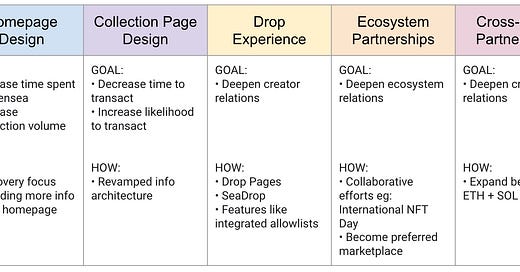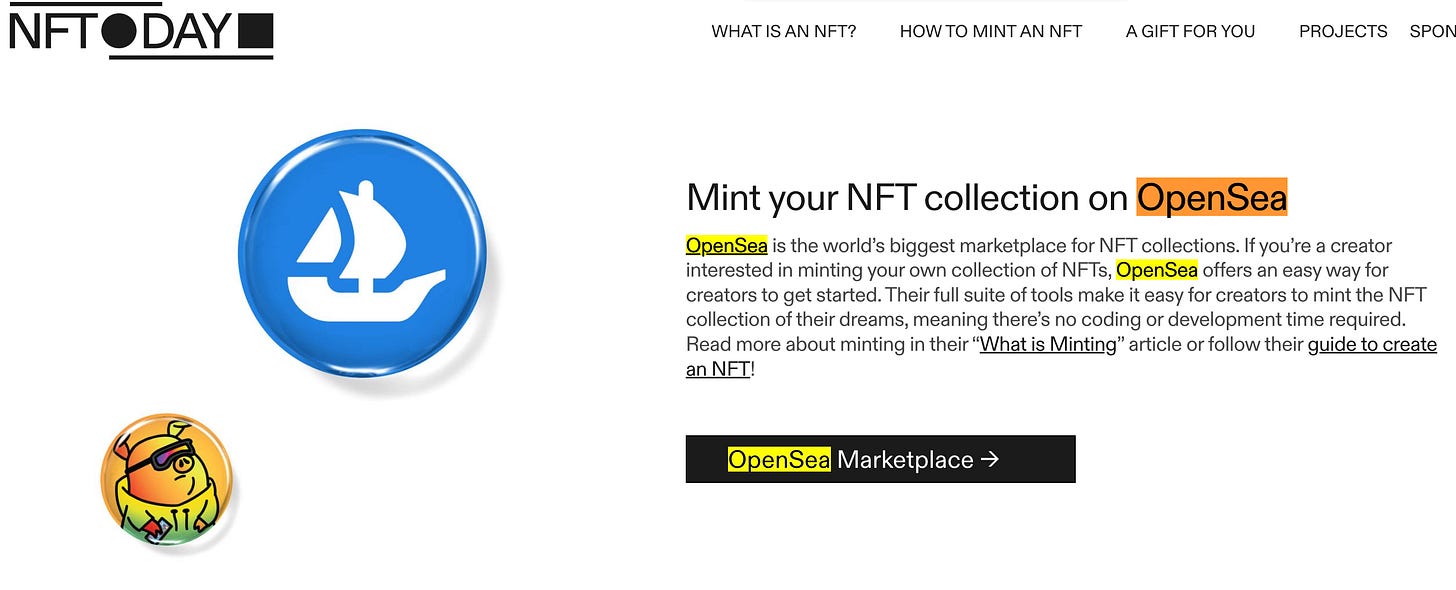I don’t know if Opensea read my piece on the Announcement Experience framework, but they have hit the nail on the head with the ‘Momentum’ dimension
Opensea has been making moves, and everyone should keep an eye on what they’re doing. Here’s why.
Design changes
Last week, the top NFT marketplace announced a slew of design changes to their website.


Old Opensea homepage:
Why was this redesign notable?
Adjusted the hero copy and placement
Old tagline was too long. ‘Extraordinary’ NFTs? Not really considering the bear market.
Note the order of the copy. Explore, collect, and sell. That was an action verb that was not in the previous hero copy
Carousel
4 featured collections in one go vs. 1 in the old homepage
Complements the explore part of the hero copy
The carousel has 3 slides
If you’re on the homepage long enough, you actually see 12 featured collections, not just 4
Trending and top collections
Used to only be accessible on the Stats section. Now you can see it on the homepage.
Further complements explore
Trending and top collections placement
Right above the fold, so users would naturally want to scroll down
As users scroll down, there are more featured categories like New and notable, Solana spotlight, and Browse by category
Opensea also made smaller adjustments to collection pages:
Old Opensea collection page:
Smalls changes, but arguably just as impactful.
Creator fees
In the old layout, it was difficult to find how much the NFT project would take for their royalty. Not anymore.
% Listed
A metric to indicate the health of a project and its community, users had to manually calculate this. Not anymore.
% Unique owners
A metric to indicate the health of a project and its community, users had to manually calculate this. Not anymore.
Information placement
Project info is now split into two rows. A subtle and smart move. Why?
Upper row is static (for the most part) data. Date of creation does not change. Creator fees rarely change.
Lower row is dynamic data. Eg: Floor prices change constantly.
Because of the info architecture the static data is smaller font while the dynamic data is larger font. Users generally want to know what the NFT collection stats are in the moment
What does this do?
Decreases the steps to make a decision for a user to buy/not buy
Reduced steps → reduced mental load → increased propensity to purchase
Drop experience
Yesterday Opensea shared the new drop experience for new projects.

The erroneous e-mail that Opensea is referring to is this one
Definitely sketchy. Don’t click on random links folks.
That said, it seems like this was an accidental send for something bigger they had in mind, and fortunately it was confirmed to be from Opensea.
Opensea shares more details on the drop experience on their blog, here’s the TLDR:
Creators will be able to launch collections with dedicated drop pages
Drop pages will have greater discoverability on the new Opensea homepage
Collectors will be able to mint directly from an Opensea page
Drops on OpenSea will have access to SeaDrop, a new, secure open source contract that powers the drops experience so that creators don’t need to create custom smart contracts
Drops on OpenSea can support allowlists, and store this information in a decentralized way.
The Drop pages —> greater discoverability point is notable. Opensea is dangling a carrot in front of creators, saying “Hey if you create a Drop page, we’ll feature you and you’ll be more likely to sell out!”
This reminds me of mobile App Stores, where developers get in the good graces of the editorial team so they can get featured and get more downloads as a result. Opensea is rewarding what they define as good behavior. (nothing wrong with this if done right IMO)
This is what the first Drop page looks like. This project will be launching in a couple days.
The URL is https://opensea.io/collection/ctomgkirby/drop. Remove ‘drop’, and you get to the collection page.
Why is this announcement notable?
This is Opensea saying: “We care about the creator ecosystem and we’re here to help you!”
Opensea has enjoyed being top dog in the marketplace game and has withstood many attempts at being dethroned (so far).
The key to most marketplaces is supply. Whoever controls supply, controls demand through marketplace economics.
This has been established in Web2 marketplace economies:
Rideshare (Uber, Lyft)
Food delivery (Doordash, Grubhub, Postmates)
Online learning (Udemy, Maven, MasterClass)
I don’t see why this would differ in Web3 marketplaces. Though Web3 has interoperability, user and creator preference still matters. The deeper the relationship with the creator, the more likely the creator/project would direct their community to a preferred marketplace.
Opensea is also aware that there are cross-chain competitors like Magic Eden that are trying to get a piece of the Ethereum NFT pie.
I’m not too familiar with Magic Eden, but it’s clear what they’re trying to do. This is an ETH project…listed on a marketplace platform predominantly for SOL NFTs.
The chess match for marketplace dominance will continue, and Opensea is looking to build a moat through supporting creators with their drop experience.
Ecosystem partner efforts
BTW, today is International NFT Day, commemorating the day that the first time the term ‘NFT’ was used in the ERC-721 proposal.

Sorta cheesy, but it seems like this will be a thing moving forward. What if it became an industry holiday and we took the day off? There are banking holidays, why can’t there be crypto holidays? 😂
You can also get a free NFT to celebrate the day here.
Opensea has already been creating relationships with the entire Web3 ecosystem, but if you take a look at who’s officially a part of this effort:
Opensea isn’t the exclusive marketplace platform on there since there’s Coinbase NFT, but they basically are considering the minimal activity on Coinbase 😉
Opensea is mentioned 9 times on the page and has their own dedicated section. Only Flow/Dapper is mentioned more because they’re leading this effort.
Cross-chain efforts
Shortly after the NFT Day announcement, Opensea comes out another, making it a 1-2 punch.

Though the Arbitrum NFT ecosystem is still young, it has been gaining momentum as a Layer 2 solution (Polygon is another example of a Layer 2 ecosystem).
Opensea launched support for Solana NFTs several months ago, and Arbitrum NFTs will go live tomorrow.
This is a win-win on multiple fronts:
Arbitrum: Access to a new (and much larger) consumer base
Opensea: More transaction volume = more revenue
Opensea partnerships signaling: Goodwill with an up-and-coming L2 and letting others know that Opensea is serious about moving beyond ETH and SOL NFTs.
Arbitrum probably gains more in the short-term, but Opensea wins as well over a longer time horizon.
Getting serious about security
Opensea has gotten criticism for a lot of things, as those at the top have a target on their backs.
However, one thing they received praise for is their commitment to security, which was also today.


$100k for finding a (probably serious) bug? I clearly am in the wrong profession. Also, this tweet went pretty viral.
Note that the bug will not be disclosed for understandable reasons.

I’m not familiar with how bug bounties work (is $100k a lot? is 12 hours fast? Probably considering the tone of the tweet),but this is huge social signaling to bug bounty hunters that creates a win-win situation for the ecosystem.
We have a glimpse of Opensea’s strategy
Holy cow, that was a lot to unpack, with most coming from just today. Let’s recap this in a TPan chart.
Though the Web3 marketplace battle for supremacy will continue, it seems that Opensea has a pretty good strategy to remain on top for the time being.
See you tomorrow folks!

















